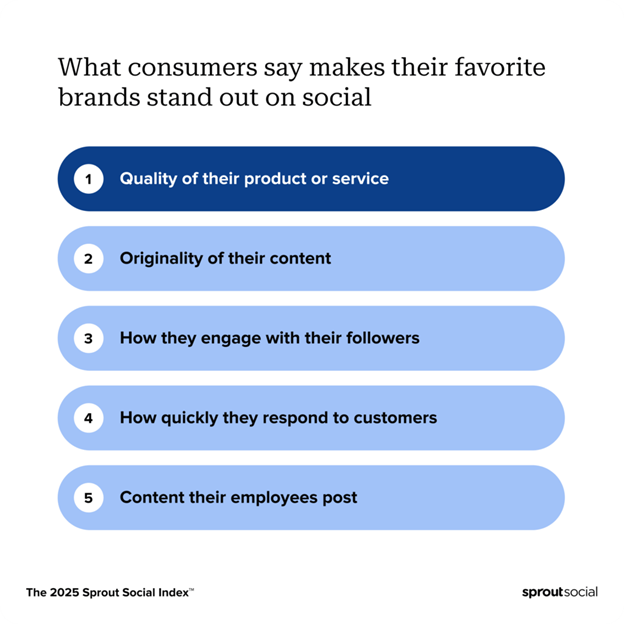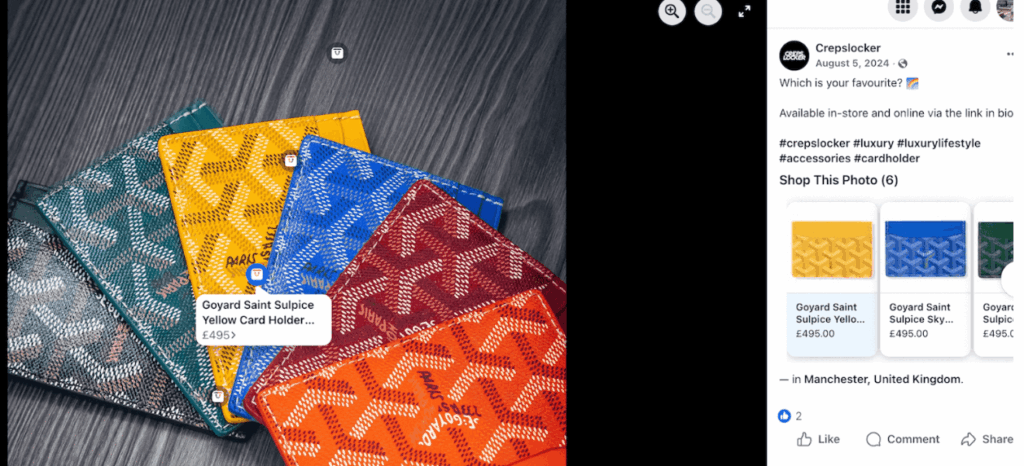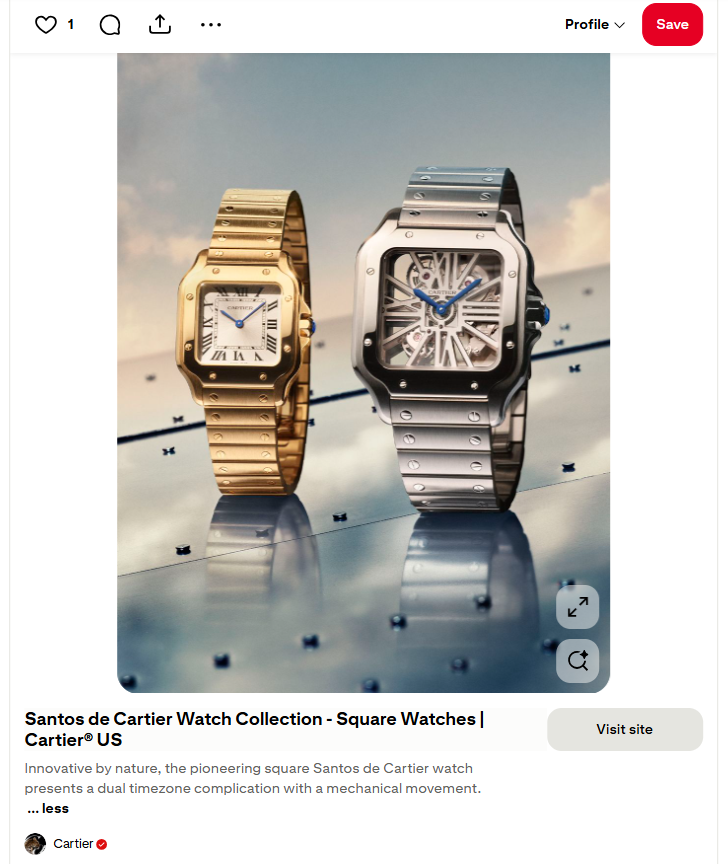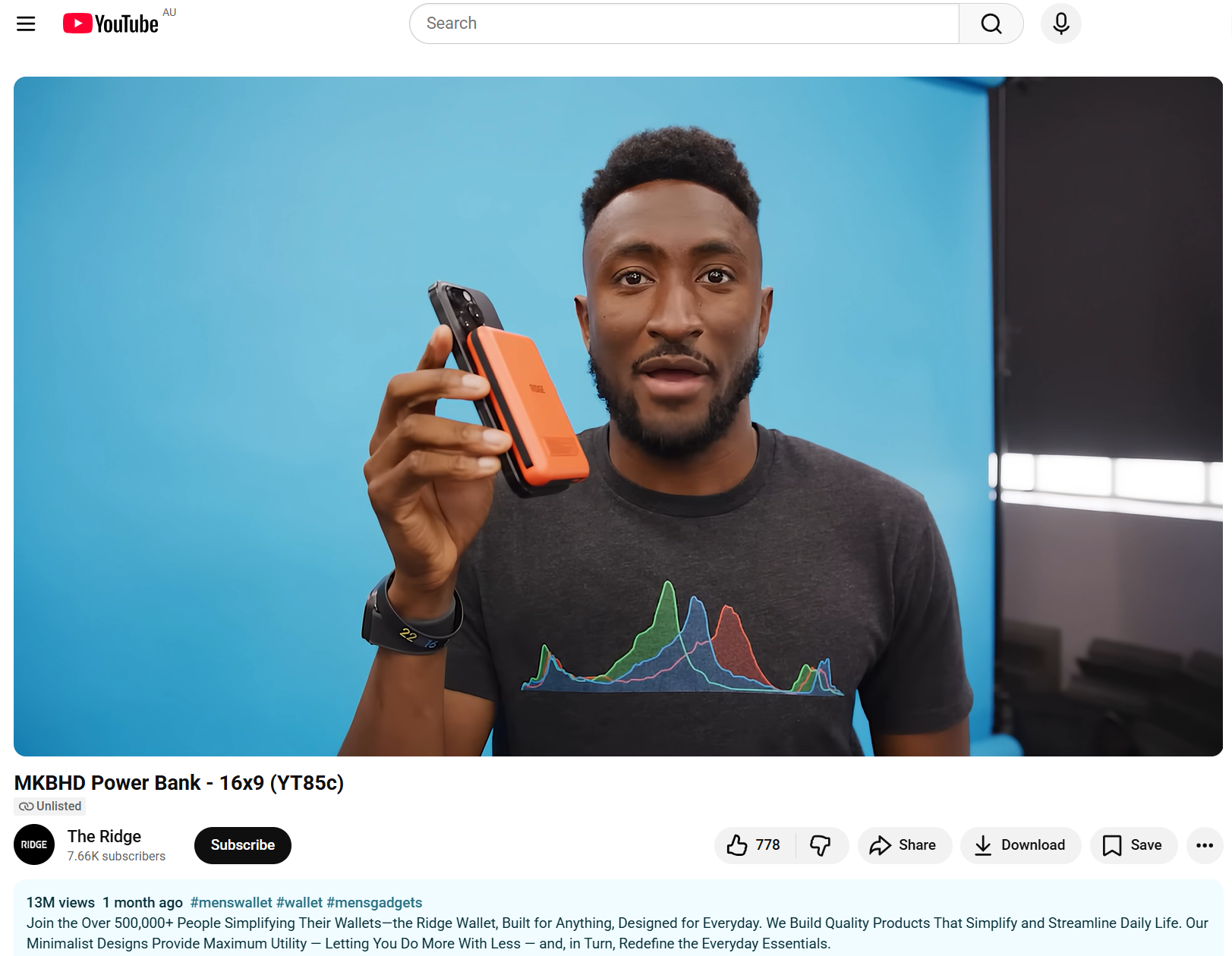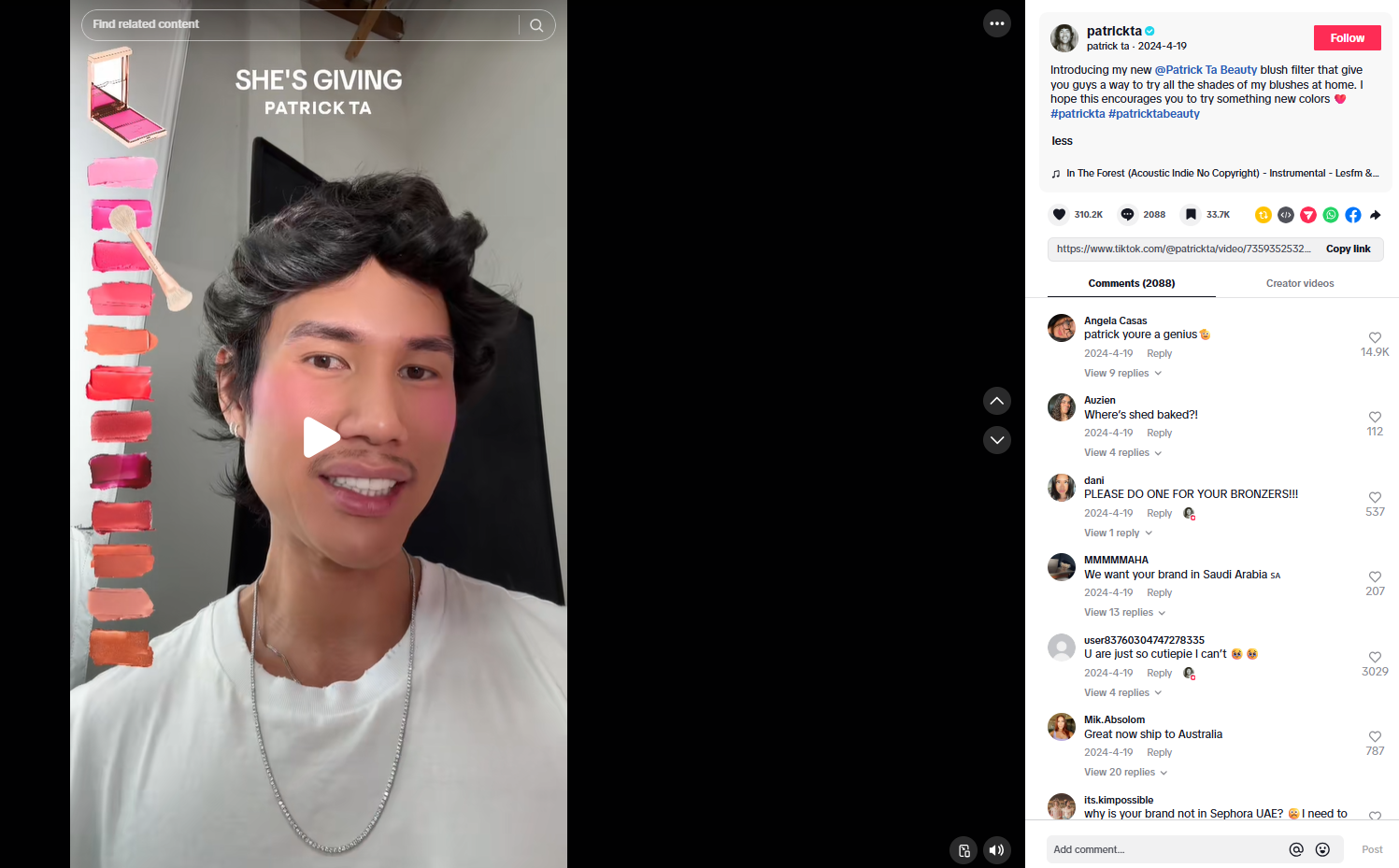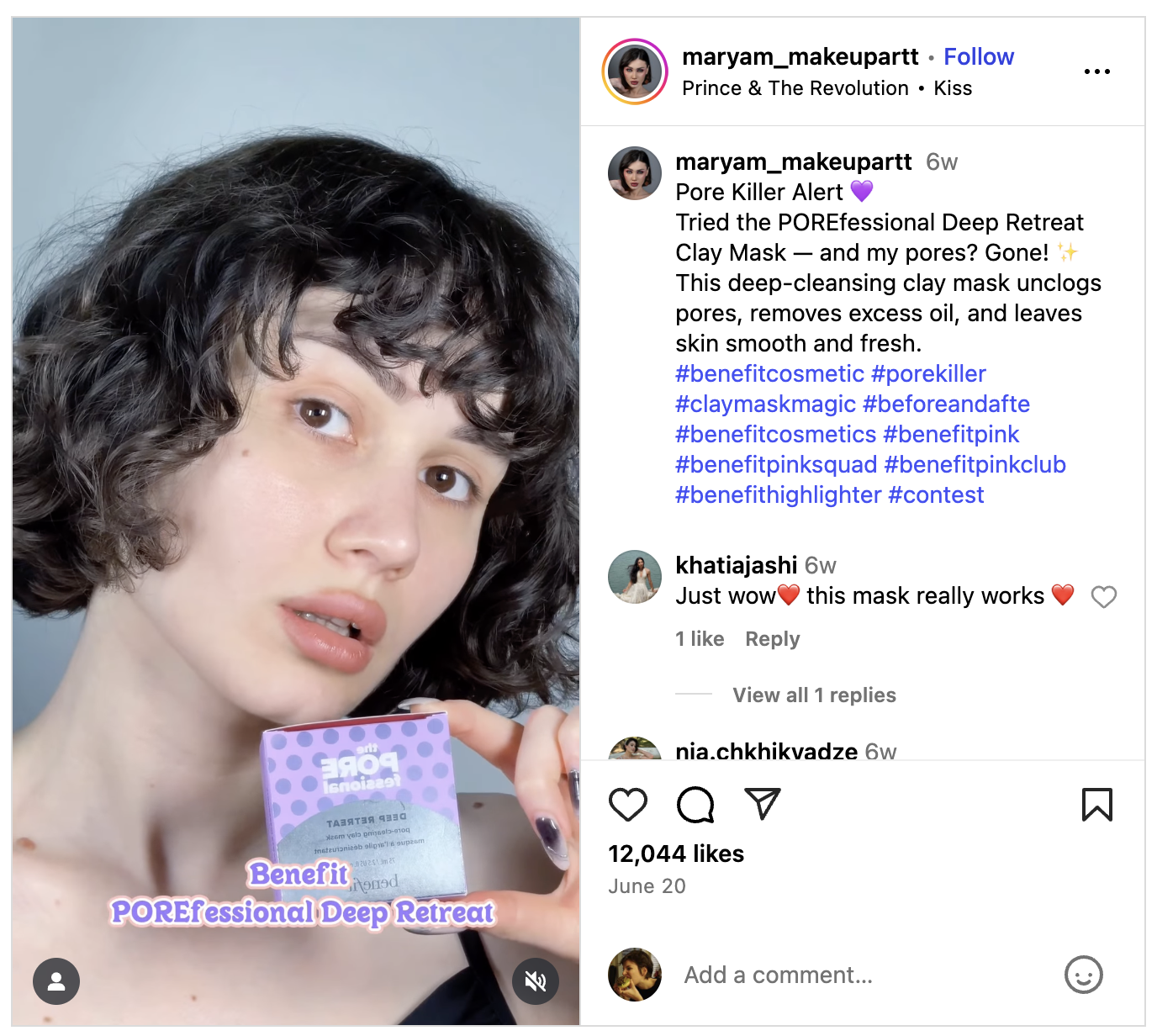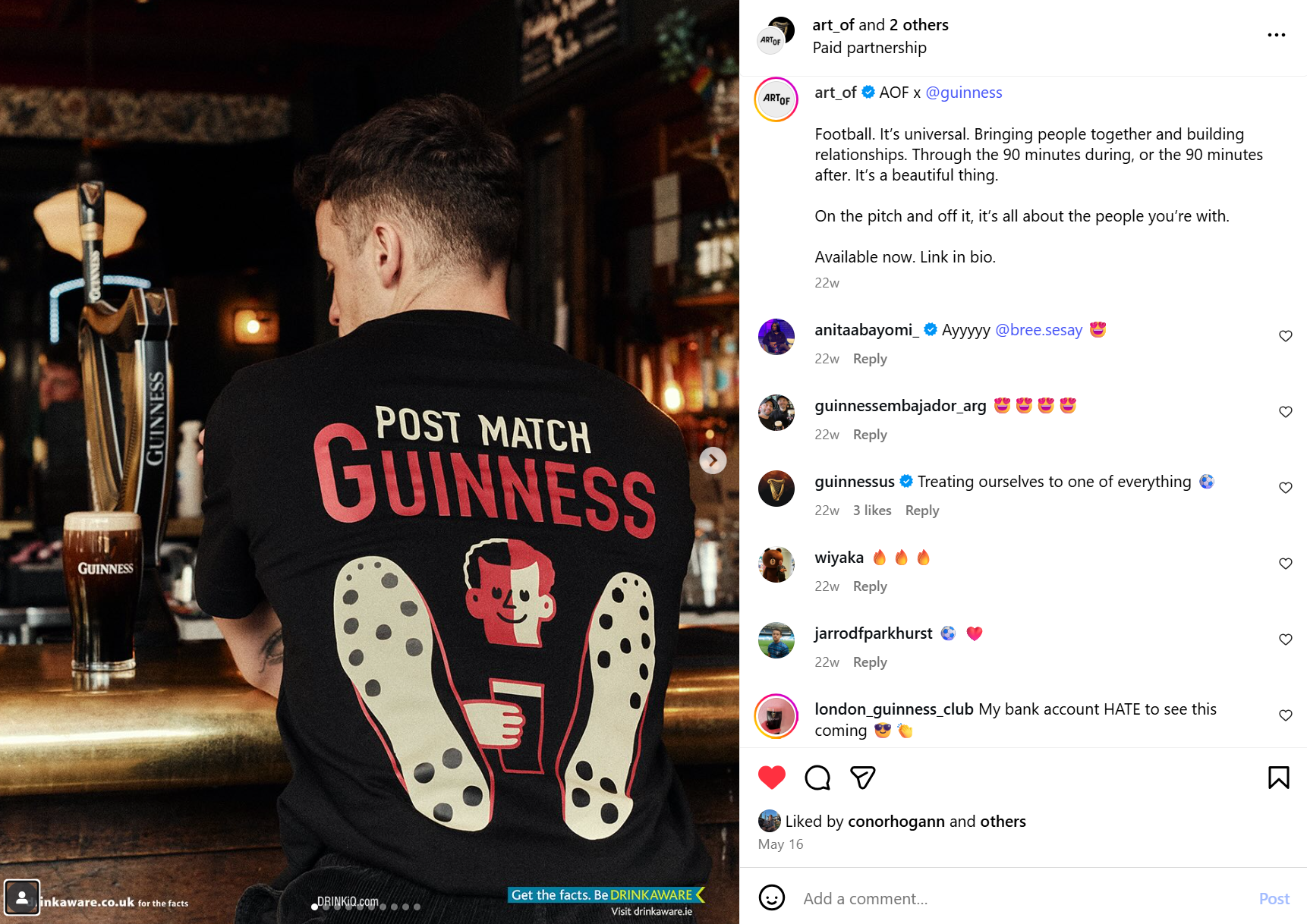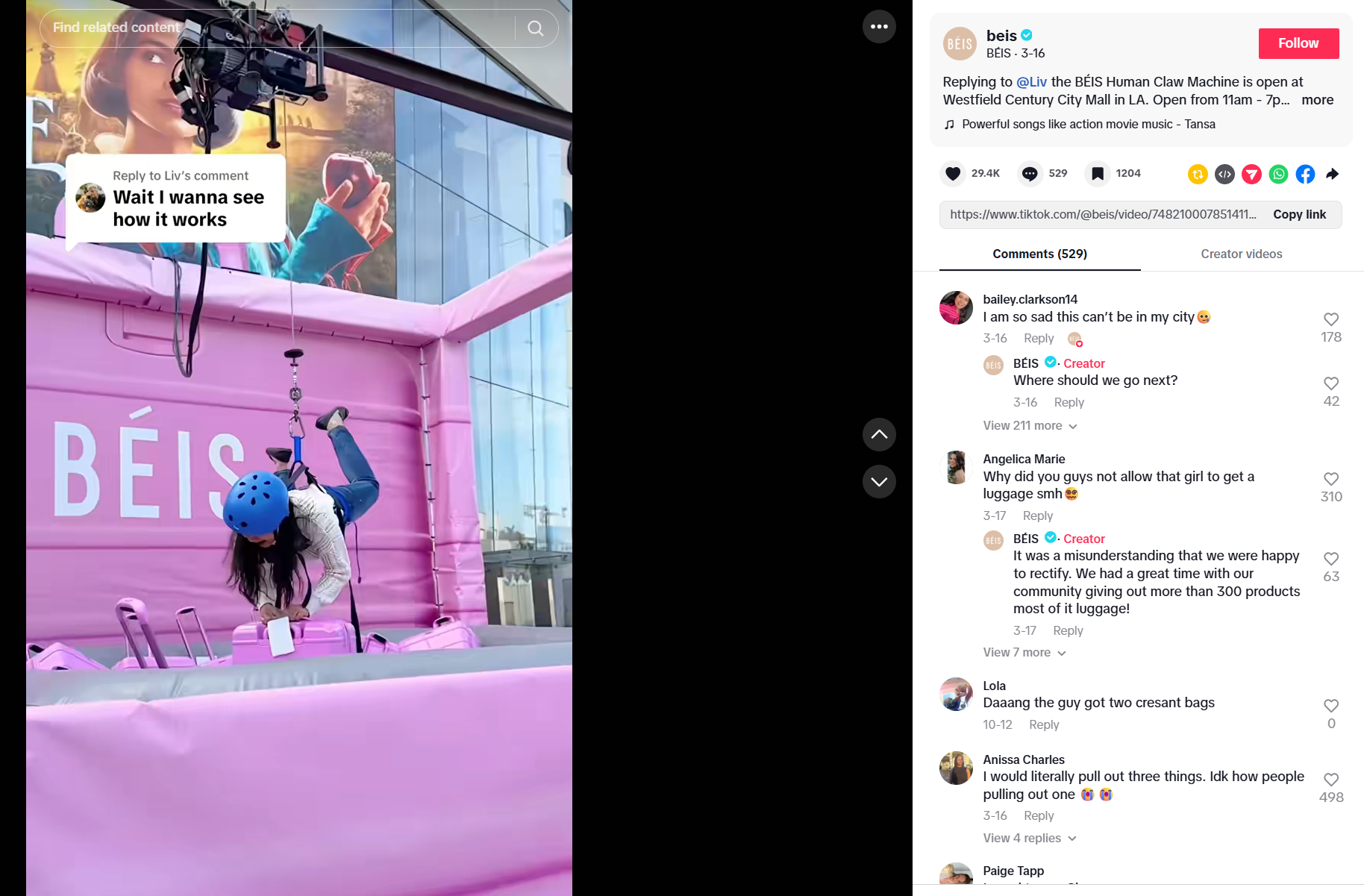It seems unimaginable for a new business to launch without any social media presence—and with good reason.
Social networks have evolved from promotional platforms into ecommerce engines, shaping how people shop, what they buy and which brands they trust. In the Q2 2025 Sprout Social Pulse Survey, 76% of all social users say social media (e.g. ads, influencer posts, brand content) had influenced some of their purchases within the past six months.
As social ecommerce grows more sophisticated and central to consumer journeys, brands will need to establish customer experiences on social media that keep up with and exceed consumer expectations. In this article, we’ll touch on what social media ecommerce is, its benefits and how your brand can create a social media ecommerce strategy.
What is social media ecommerce?
Social media ecommerce is the practice of marketing an ecommerce business using social media to drive traffic, loyalty and sales.
Brands may even close sales directly on social media networks. This practice is known as social commerce. There’s also mobile commerce, a subset of social commerce that involves selling products on mobile devices (think dedicated apps and mobile browser transactions).
Social media ecommerce is unique from social media marketing. The main difference between the two is the objective.
The primary goal of social media ecommerce is to increase online sales, either by directing traffic to a digital storefront or selling products directly on social networks.
Social media marketing is the more general practice of promoting any kind of brand on social. Its objectives could include broadening brand awareness, increasing audience engagement or driving other types of conversions, such as consultation bookings or newsletter sign-ups.
The current state of ecommerce on social media
Before we explore the future of social media ecommerce, let’s take a look at where the industry is today.
Social media ecommerce market size
The ecommerce sector is thriving, with global revenue projected to reach $3.66 trillion in 2025. With an expected annual growth rate of 6.29% for the next five years, its market volume is set to reach $4.96 trillion by 2030.
Social media is driving a significant portion of that revenue. In 2025, social media sales accounted for approximately 17.11% of total online sales.
In the coming years, social commerce revenue is expected to boom. In 2024, social commerce’s estimated revenue was $683 billion. This figure is set to surpass $1 trillion by 2029.
Social media ecommerce consumer behaviors
Consumers are increasingly turning to social for product discovery as well as purchasing, according to our Social Media Content Strategy Report. It reveals Instagram as a key platform for product discovery, with 61% of respondents using it to find their next purchase. For Gen Z, TikTok is the network of choice, with 77% using the platform to seek out new products or product updates.
But when it comes to direct purchases, Facebook takes the top spot, with 39% of consumers turning to it when they’re ready to buy.
Consumers are also welcoming emerging trends, such as in-app checkouts and live social shopping, which sees brands livestreaming to showcase their products, engage with their audience and push sales in real time. In 2024, some of the most live-purchased products included clothing, cosmetics and skincare, and fashion accessories.
Social media ecommerce consumer demographics
Younger generations are leading the pack of social consumers. As we mentioned earlier, 76% of users said social media influenced some of their purchases in the last six months. But that figure jumps up to 90% for Gen Z and 84% for Millennials.
Our Q2 2025 Pulse Survey also found these generations are more likely than others to buy something they saw on social. For Gen Z and Millennials, 43% and 36% said they were more likely to buy, respectively.
In terms of geography, social media ecommerce is most popular in Asia. Specifically, China and Thailand boast some of the highest percentages of social commerce buyers, with 95% and 94% of online shoppers making purchases on social media in 2024.
Social media ecommerce has quickly proliferated to other corners of the world, with Peru, Colombia and India following behind.
Social media ecommerce growth drivers
Social media ecommerce is expanding thanks to several elements, chief among them the rise of influencer and creator-led product discovery. Social users aren’t just turning to influencers for entertainment or aspiration—they’re looking for guidance on what products to buy and which brands to trust.
According to our Q2 2025 Pulse Survey, 64% of all social users say they’re more willing to buy from a brand if it partners with an influencer they like. This rises to 76% for Gen Z and 74% for Millennials.
If these statistics tell us anything, it’s that consumers trust influencers—and trust is crucial in driving purchases. Brands can tap into this trust further by investing in user-generated content (UGC), such as reviews, testimonials and unboxing videos. Leveraging content made by real people fosters the sense of authenticity that consumers crave.
Community engagement and social customer care, such as replying to DMs and comments, are also important to consumers. Per The 2025 Sprout Social Index™, brand responsiveness is one of the top five things that help businesses stand out social.
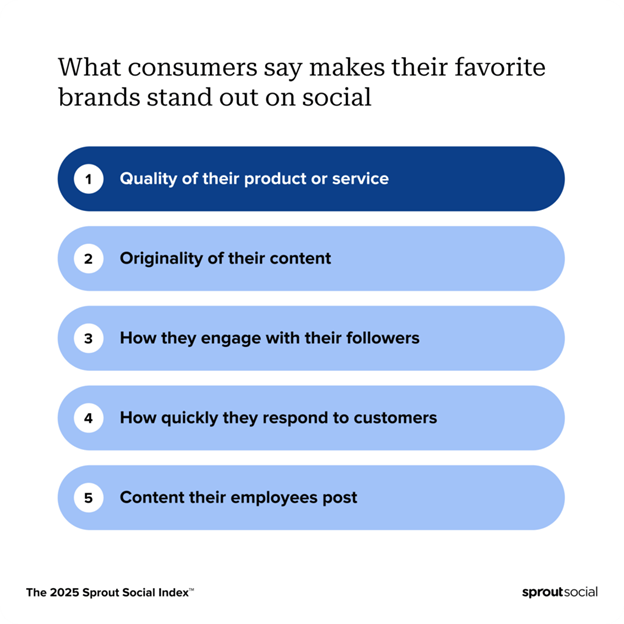
Technology innovations are also major growth drivers, with two specific types taking precedence: seamless payments and AI-driven social media algorithms.
Of all payment innovations, in-app checkout is one of the standouts. For example, TikTok Shop enables users to buy products they see in shoppable videos, livestreams, Shop Tabs and Shop Pages. Similarly, the catalog feature on WhatsApp Business encourages users to complete purchases in-app using the cart tool.
Meanwhile, personalized algorithms dictate content visibility, sequence and recommendations based on past behaviors and interests. So, users aren’t discovering ecommerce content by chance—their feeds are continuously introducing them to products and brands that align with their lifestyles and buying habits.
Benefits of social ecommerce
Whether your business exists solely online or you’re expanding to an online presence, you’ll need social media ecommerce to push direct sales. Social media ecommerce is one of the most powerful ways to drive revenue on social because it offers several benefits to buyers and brands.
Reduce friction in the buying process
Social ecommerce helps users transition from discovery to checkout more quickly and seamlessly. Rather than jumping between search engines, social networks and websites to complete a simple purchase, users can complete their buying journey in one place.
For example, say someone was seeking a new pair of running shoes for their upcoming marathon. On Instagram, they see one of their favorite fitness influencers promoting a new drop of race-day runners via a shoppable post. By clicking on it, the user can see all the must-know details, including sizing and pricing. Better yet, with in-app checkout, they can place their order directly on Instagram—and no redirects mean fewer abandoned carts.
Increase customer loyalty
Social media is a go-to outlet for customer care and support. Nearly three-quarters (73%) of users expect a response within 24 hours, according to data from the 2025 Index. Additionally, the same proportion says they’ll buy from a competitor if a brand doesn’t respond on social at all.
With that in mind, there’s ample opportunity for ecommerce brands to foster customer loyalty on social. Respond promptly to queries, address problems and show appreciation for customers in the comments. Such simple actions go a long way in showing that you care about their experience, not just their spending.
By consistently showing up for your customers and demonstrating genuine care, you’ll encourage them to come back again and again.
Increase ROI
Social media ecommerce also has the power to improve your social media ROI.
Shoppable posts enable you to drive traffic to your website or in-app store to increase sales. Social proof demonstrates how your products address real pain points, fostering loyalty and boosting conversions over time.
Social customer care tools can also help brands respond to queries faster, in turn reducing customer frustrations, strengthening loyalty and increasing sales. Plus, by monitoring and engaging with their community, brands gain valuable insights into consumer preferences. With this information, businesses can refine their products, services and operations to drive even better results.
Together, these factors help you get more value out of every dollar spent, whether on social ads, influencer partnerships or content creation.
Which social media is best for ecommerce? A network-by-network breakdown
Below, we walk you through the top social media ecommerce networks and the role they can play in your strategy.
TikTok
Short-form video is immensely popular, surpassing image-based content across networks. But no network has contributed to this boom quite like TikTok.
According to the 2024 Content Strategy Report, TikTok users were most likely to engage with short-form videos lasting between 15 and 30 seconds. Videos under 15 seconds and videos running for 31-60 seconds came in second and third place, respectively. Such brevity is ideal for fast-scrolling social users who crave quick entertainment and easy paths to purchase.
One of TikTok’s key strengths is its algorithm, which surfaces content from brands and individuals, regardless of follower count. Instead, it looks at factors like engagement, user interactions and video information. For instance, creator-led trends—which may include trending audios, hashtags or effects—often perform well in the algorithm because they have high levels of engagement.
So, TikTok is ideal for your business if you hope to incorporate trends into your social ecommerce strategy. According to Clinique’s Senior Brand Engagement Manager, Lysis Bourget-Vennin, that’s exactly what the beauty giant is doing to make money on TikTok.
“If you want to have a trend-forward approach, which is usually what we do on makeup, we’re gonna be focusing a lot more on TikTok through the influencers that we’re selecting [for partnerships],” she said at Sprout’s Glow Beyond the Grid webinar.
Instagram and Facebook
Instagram and Facebook largely dominate the social ecommerce space. Per the 2025 Sprout Social Index, both networks fall in the top three people use to make purchases. Facebook claimed the top spot with 39% of users making purchases on it, while Instagram took third place with 29% of users.
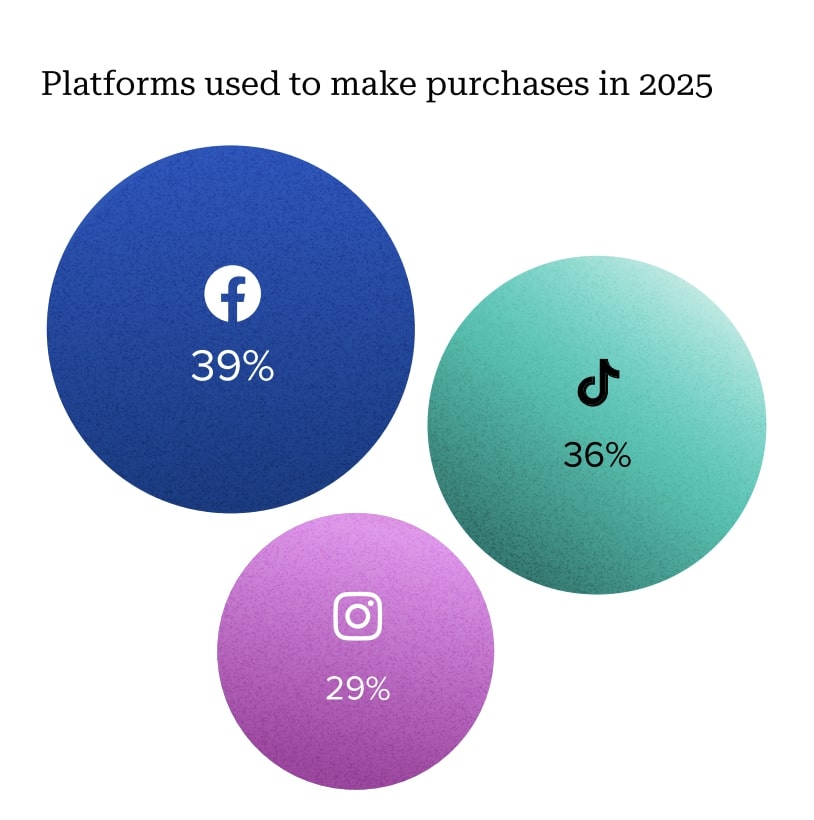
When you create an Instagram Business account, you can leverage a variety of features perfect for ecommerce, including shoppable posts and in-app checkout. With Instagram Shopping, users can simply tap on a product in your post, view the listing and buy it without ever leaving the app.
Facebook Shops function in much the same way. Brands can have storefronts on their profiles (denoted by the “Shops” tab on the menu bar), tag products in posts and drive website traffic, encouraging users to browse other products and make purchases.
These are some of the best practices employed by UK-based luxury goods store, Crepslocker. It features shoppable tags in many of its Facebook posts, allowing users to click on specific products, learn more about them and buy them on the spot.
Pinterest is where users come for inspiration, whether it’s home decor, fashion or anything in between. According to Pinterest, 80% of weekly Pinners feel inspired by the network’s shopping experience. On average, Pinners spend twice as much on Pinterest as they do on other social media networks. This willingness to spend more could be the result of Pinterest users’ high incomes, with one-third earning over $100K per year.
As a result, selling on Pinterest is particularly well-suited to ecommerce brands offering high-ticket products, such as designer items, furniture or electronics.
Luxury watch and jewelry brand, Cartier, uses Pinterest to showcase high-quality, eye-catching product visuals and includes CTA buttons to drive website traffic.
YouTube
YouTube marketing is integral for ecommerce brands. A hub for unboxings, tutorials and reviews, the platform plays an integral role in product discovery and research. Whether it’s upgrading their phone or investing in new wardrobe staples, consumers often turn to YouTube to see what other shoppers are saying about a product before actually buying it.
With this in mind, it’s unsurprising that consumers’ engagement with brands on YouTube is so substantial. Per the 2024 Content Strategy Report, 47% of YouTube users interact with brands weekly, while 32% engage daily.
Influencer engagement on YouTube is similarly significant. Per data from Sprout Social Influencer Marketing, YouTube influencers generated 28.4 billion engagements in 2024 in the U.S. alone. This makes it one of the most engaged networks for influencer content.
Take YouTuber Marques Brownlee as an example. Brownlee specializes in tech product reviews on his channel. His 20 million subscribers look to him for honest, credible breakdowns and recommendations on everything from smartphones to laptops to gaming consoles.
Partnering with creators like Brownlee gives brands direct access to their highly engaged and trusting audiences. In turn, a single collaboration can drive significant awareness and even sales for an ecommerce brand.
The Ridge—an ecommerce brand specializing in sleek metal wallets and power banks—did exactly that in a YouTube ad they created, with Brownlee showcasing some of the power bank’s coolest features, such as seamless Apple Watch charging and a kickstand. Although the video was posted to The Ridge’s YouTube channel, having an established figure like Brownlee in front of the camera lent the content credibility.
5 pillars of a successful ecommerce social media marketing strategy
Before you start promoting your ecommerce business on social media, familiarize yourself with the five-pillar framework used by winning brands.
1. Authenticity and the UGC engine
Ecommerce competition on social media is fiercer than ever. With countless other brands vying for consumers’ social attention, how can you set yourself apart?
One way is to establish and nurture brand authenticity. This refers to whether consumers believe a brand is genuine about its products/services, promises to customers and values.
Foster brand authenticity with UGC, which can come in the form of customer reviews and testimonials, videos, blogs, comments and more.
Because it’s everyday people creating the content (instead of celebrities), it inherently feels more genuine and relatable—the top two traits users crave in brand content, per the Index.
When consumers relate to the content, they’re more inclined to purchase the showcased products. A TurnTo study discovered that 87% of consumers believe UGC affects their buying decisions, while 81% of consumers are willing to pay more and wait longer for delivery for products featuring authentic UGC.
2. Shoppertainment
On social media, consumers don’t want to just be sold to—they want to be captivated. While authenticity and relatability are the top two things users crave from brand content, entertainment is close behind in third place.
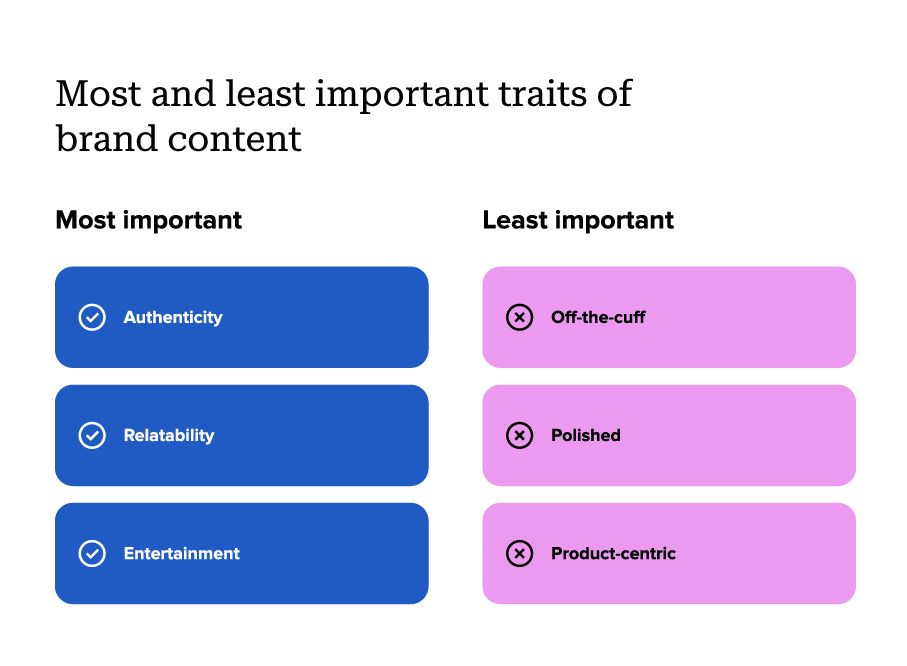
That’s where shoppertainment comes in.
A blend of ecommerce sales with entertaining content, shoppertainment tactics move beyond static posts and into more immersive experiences. These might include livestreams (such as real-time Q&As), augmented reality (AR) filters or hashtag challenges.
For example, when Patrick Ta launched a new blush line in 2024, the brand created an AR filter on TikTok, allowing users to virtually test the shades. Combining interactive fun with seamless product promotion, the filter is a prime example of shoppertainment at play.
3. Frictionless experience
From discovery to purchase, every step of the customer journey should be seamless.
Make your products discoverable through influencer partnerships and social search optimization. Then, once you’ve got your audience’s attention, ensure that the buying process is smooth and intuitive with shoppable content and in-app checkout.
From there, streamline the process even further with the help of automated customer service tools, such as AI-powered chatbots. Use these tools to answer customer queries instantly and resolve issues in real time within each network.
4. Personalization
According to the 2025 Index, consumers believe that companies should make personalized customer service their top social media priority.
The best way to deliver on that expectation is to invest in social customer care. Monitor mentions, comments and feedback across networks to keep tabs on your customers’ experiences. Use tools like chatbots to provide customers with support when and where they need it. Where appropriate, follow up with personalized comments and DMs to create a more human connection.
While the biggest impact comes from being responsive in real, social listening also plays a role. The data can help you identify common customer questions, preferences or pain points, and adjust your customer care strategies accordingly.
Tapping into niche communities and engaging with them is another effective personalization tactic. By immersing yourself in their world and actively participating in their discussions, you’ll gain an intimate understanding of your audience’s values, interests and behaviors. You can then use that knowledge to customize your content or interactions accordingly.
5. Performance tracking and attribution modeling
With the right tracking and attribution modeling, you’ll gain insight into how different social interactions—comments, shares or clicks—impact your bottom line.
Start by measuring KPIs that align with business goals, such as click-through rate, conversion rate, cost per acquisition (CPA) and return on ad spend (ROAS).
For Clinique, Bourget-Vennin shared that engagement rate and earned media value (EMV) are two key metrics for the brand.
“We’re seeing that EMV is very important, but if we do not have the engagement from our communities, we’re not seeing the same results,” she said.
Additionally, see which social campaigns drive actual conversions with tools like platform or campaign-specific UTM codes and pixels.
A strong martech stack is crucial here. Ecommerce tools, Google Analytics, and CRMs, alongside social media management tools like Sprout all have a role to play in providing a full view of the customer journey and reducing operational complexity across channels.
3 examples of social media ecommerce
Let’s take a look at three examples of successful social media ecommerce campaigns in action.
1. Care to Beauty
Specializing in dermatologist-backed cosmetics, Care to Beauty doesn’t just sell beauty products—it helps its customers create skincare routines that actually work for them. While headquartered in Portugal, Care to Beauty serves customers in over 180 countries.
To reach this global customer base, social media ecommerce has been a must. The brand has leaned heavily on influencer marketing, forging relationships with creators as passionate about self-care and science-backed beauty as the brand itself.
Using Sprout Social’s Influencer Marketing, Care to Beauty reduced time spent on creator vetting by 75%. Less time spent on vetting means more time spent on what matters most: cultivating relationships with customers.
Educational content is also at the core of the brand’s social ecommerce strategy. Care to Beauty often posts informative, direct-to-camera product breakdowns on topics like gentle makeup removers to dark skin-friendly SPFs. It’s a simple yet effective tactic that offers real value to followers and seamlessly promotes its products.
2. Guinness
Although Guinness is one of Ireland’s most iconic drinks, the brand is much bigger than just the beverage. Established in 1759, Guinness has long been a staple in Ireland’s commercial landscape. So, it’s unsurprising that it’s evolved into a major player in ecommerce, including social media ecommerce.
While you can’t buy the beer online, you can buy other forms of merchandise, including glassware, food and wall art. Guinness also sells everyday clothing and sportswear, such as golf shirts and sports jerseys.
On social media, the brand echoes this love of sports—something that resonates with its predominantly male customer base. And it often showcases this passion in ways that simultaneously promote its brand and products.
For instance, Guinness partnered with Art Of—a fan-led football merchandise brand—in May 2025, launching a collaborative line of branded clothing.
Not only did Guinness seamlessly showcase purchasable products, but it tapped into the values and interests it shares with its audience (i.e. sports, culture and community). Instead of simply pushing its products, the brand reinforced its authenticity and relatability to support the fandom and foster loyalty.
3. BÉIS
BÉIS offers luggage and bags that are durable yet luxurious. While its products stand out thanks to their unique colors and sleek designs, the brand’s social media strategy is what truly sets it apart.
Across its socials, the brand embraces UGC, often sharing content posted by real customers, such as unboxings, “what’s in my bag” videos and static images. Organic and trustworthy, this social proof enables users to envision themselves using and loving BÉIS products.
Plus, BÉIS is an expert at shoppertainment, often using out-of-the-box methods to keep social users engaged. A perfect example is when the brand hosted pop-up events featuring a human claw machine. Attendees were lowered over a pit of BÉIS merchandise, getting the chance to secure their own suitcase.
Although the event took place offline, it married entertainment and commerce into one cohesive experience, as shoppertainment is meant to do. Not to mention, it generated significant buzz on social media, helping increase brand awareness and drive online sales.
Tactics to optimize your social media ecommerce for now and the future
Now that you’ve seen effective social media ecommerce in practice, here are some specific tips to help you master it.
Master product tagging and catalog sync
To create a cohesive experience for shoppers, sync your product tagging and cataloging across all social ecommerce touchpoints, including Facebook Shops, Instagram Shopping, Pinterest and TikTok Shop. Doing so will ensure that consumers get the same product information (e.g. price, sizing, availability) no matter where they discover your brand.
Optimize listings further by including relevant keywords in product descriptions and tags. This will improve searchability within each network, showing your products to high-intent users actively seeking them out.
Leverage the creator economy strategically
Tapping into the creator economy is one of the most powerful ways to build trust and credibility. But it’s not enough to partner with any creators—you need to choose the right creators for your audience.
Authenticity and credibility are everything. Ideally, look for creators who use and love your product—a page straight from Clinique’s playbook.
“We will not go into a paid partnership unless there is a real brand fit between the influencer and Clinique. So there needs to be organic involvement and organic love between the brand and the influencer prior to us evolving into a paid partnership,” said Bourget-Vennin.
Additionally, don’t focus solely on follower count. Instead, seek out creators—big and small—who speak directly to the audiences you want to reach. In some cases, this could mean partnering with smaller creators who often have higher engagement levels.
Say you run a sustainable fashion brand; you may get more traction by partnering with micro influencers who share thrifting hauls and upcycling tips, rather than a mainstream fashion influencer. Although their audiences may be smaller, they genuinely care about the environment, making your messaging more relevant and impactful.

To measure the outcomes of these partnerships, implement affiliate links, UTM tracking and exclusive discount codes tied to specific campaigns. Tracking and analyzing this data is critical to proving ROI and refining future campaigns for optimal results.
Implement social listening for inventory and trends
Use social listening tools to monitor conversations, hashtags and emerging trends or topics related to your business or industry. Then, use those insights to make informed decisions about your content and/or inventory.
For example, you might notice an increased affinity for orange and mint tones following the release of Taylor Swift’s album, The Life of a Showgirl, which features the two colors on the cover. You could then promote your products in these colors more heavily on your social accounts or increase stock to prepare for a potential surge in purchases.
This approach helps you stay on top of cultural and commercial trends, instead of trying to catch up to them.
Always-on creative optimization
Keep your brand top of mind on social by maintaining a consistent posting cadence, while simultaneously testing variations of ad copy, visuals, video duration and CTAs. Review each of these variations to see what resonates with users (i.e. what drives the most engagements and conversions). Then, make small adjustments to your existing content and inform future content development to align with these preferences.
Embrace AR and virtual try-ons
AR filters and virtual try-ons bridge the gap between online browsing and in-person shopping. Immersive and interactive, these tools allow shoppers to visualize how a product will look or fit before purchasing—all from the comfort of their own homes.
Whether it’s testing out blush shades or seeing how a piece of furniture will look in a space, AR helps reduce purchase hesitation. It also helps recreate the in-person shopping experience within the digital space by enabling consumers to interact with products in tangible ways (even through a screen).
Create your social media ecommerce strategy today
The social media ecommerce sector has transformed dramatically—and it’s showing no signs of slowing down.
In the near future, generative AI will likely automate administrative (e.g. product tagging) and customer care (e.g. conversing with shoppers) tasks alike. Predictive commerce will assist in anticipating shopper needs and forecasting future behaviors before they even search. And personalized feeds will continue to evolve, offering product recommendations and promotions uniquely tailored to the individual.
To future-proof your social media ecommerce toolkit, give Sprout Social a test drive. Access tools that can help you monitor your online presence, market to the right audience and keep an eye on your social media analytics.
The post How to use social media ecommerce effectively in 2025 appeared first on Sprout Social.

